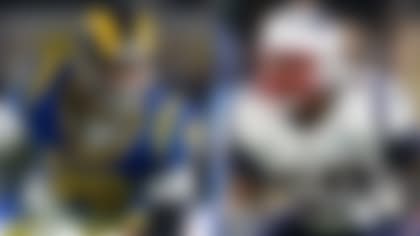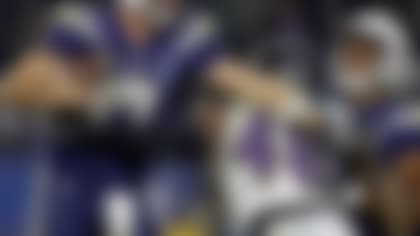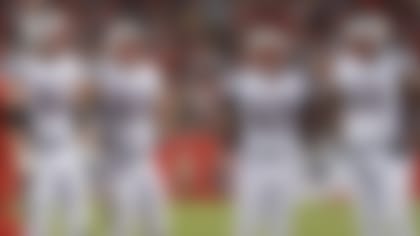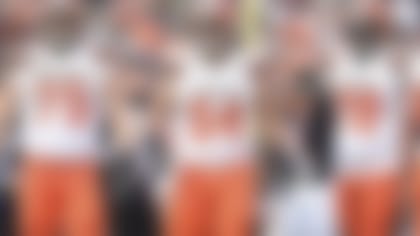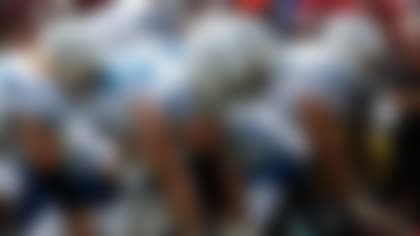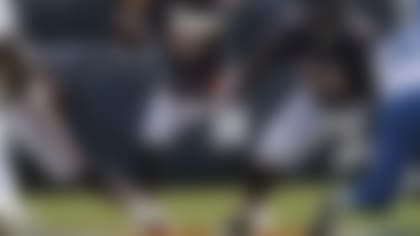It's been said more and more in recent years, and it isn't going away any time soon: the NFL is a passing league.
But passing isn't just a competition of the strongest, most-accurate arms and most talented receivers. Much like how an effective running game begins and ends with the men opening holes and creating alleys, the passing game can only flourish behind a group of dependable, agile linemen.
Tackles, guards and centers must be able to drop in protection, slide and even fake certain protections before the true play is revealed. Below are a few of the more common techniques you'll see in today's passing games.
Pocket protection
It's simple in nature. Five men drop in unison, forming a curved pocket to protect the quarterback, also dropping to pass from under center, or taking a shotgun snap before standing among the protection. The linemen keep defenders in front of them and off the quarterback as he scans the field. It's natural to see in today's game, but it wasn't always that way.
The concept of a passing pocket began with Paul Brown's Cleveland Browns. In early highlight reels of one of pro football's dominant franchises of the 1950s (with Detroit being the other), announcers even refer to Otto Graham as dropping to pass in "the golden cup," and later, the pocket.
From this basic protection grew the value of a left tackle, a blindside protector of the passer, who was almost always right-handed. But a good pocket actually starts from within. Because the quickest path to the quarterback is through the middle of the line, the center and guards must be quick to react, disciplined to stay home during their pass drops and as quick laterally as they are in shuffling backward.
Below, Washington created a clean pocket for a deep pass from Kirk Cousins to Jamison Crowder. Yes, the line had help thanks to the shotgun.
The footwork of a pass drop itself is also a move that is more intricate than it appears. Coming from either a two- or three-point stance, the lineman pushes off his inside foot (staggered slightly forward in a stance) while retreating backward with his outside foot. The staggered stance remains with each pedal backward, with the lineman keeping his eyes up and head on a swivel, tracking the defender(s) he's going to block.
Keeping the head on a swivel is key, because this isn't the Dark Ages. Defensive linemen aren't going to rush in a straight line every time, and offensive linemen need to react accordingly. This is where the inside, staggered-forward foot comes into play. In the drop, the outside foot leads the drop, but to move laterally, the inside foot leads or powers the shuffle left or right.
Linemen need to pass drop with quickness while retaining a wide base to keep power upon setting the feet and engaging the defender. This is especially true for tackles, who are facing increasingly athletic and fast edge rushers. Some players are on a roster just to rush the passer. They're going to be quick out of a stance, so a tackle needs to be just as quick -- while moving backward.
This is where the elite tackles separate themselves from the rest, because the pass drop becomes a race to the edge. As the quarterback drops with a three-, five- or seven-step drop, the tackle must keep the edge rusher from getting around him and into the chest or backplate of the quarterback. The deeper the quarterback drop, the deeper the lineman's drop -- and the more room for error.
The top tackles can and will win close to 80 percent of races to the edge. The best of the best also will be agile and quick enough to pass drop in a race while maintaining the wide base to shuffle inside against an inside move, all while retaining the wide base to avoid getting knocked over upon impact. If you see a defensive end put a tackle on his backside, run the play back and watch his feet. It's more likely than not that the tackle's base became too narrow, making him a pillar to easily knock over.
There's also slide protection, which is an extension of a pocket that requires more lateral movement than depth. Centers are important for communication among linemen, and perhaps no more vital than when determining neccesity and direction of slide protection. Below is a good example of Tennessee sliding left to combat a Green Bay blitz.
Going low
Let's get this out of the way: going high-low on a defender is illegal, it's dirty and it's uncalled for. We clear on that? Good.
Having said that, there is plenty of value in going low to pass block a defender. A pass-rusher's first goal is always to get to the quarterback, but if that isn't possible in the three-second-or-less window common in the NFL, their second goal is to get their hands up to close off throwing windows and bat passes down at the line.
So if you're Coordinator X, idolizer of Bill Walsh and the West Coast offense, who rides or dies on the three-step drop and quick slants, how do you get these passes off without interruption? You tell your offensive linemen to go low.
Going low can be a cut block, aimed at cutting down a lineman, or a block below the waist that, well, elicits the natural reaction of protecting the general groin area. More importantly, it gets those pesky hands down.
There's plenty of simple terminology for this style of block, with some being unfit to print. My favorite acceptable nickname is Peter block. You can figure out the rest.
Teams have started to employ this block in single situations, with Oakland going low for cut blocks on defensive ends when trying to execute quick passes to the flats. Sometimes it works; sometimes it doesn't.
Screen
It's been around for a long time, but few plays are as beautiful and equally as satisfying as the screen.
It starts as a typical pass protection, and feels like that against defensive linemen at first. But after a count of usually two seconds, offensive linemen let their man rush past them for a free shot at the quarterback -- except he's already lofting the ball over the defenders, and the linemen are five yards downfield in a convoy ready to escort the running back to paydirt in one big "got 'em" moment.
There are plenty of variations of the screen involving tight ends, receivers (I curse the bubble screen), and even throwback screens to quarterbacks and an eligible tackle (2017 draft prospect Forrest Lamp). A well-executed tight end screen is below, run by the Saints against the Rams in 2016.
And for those of you who are fans of traditional screens...

